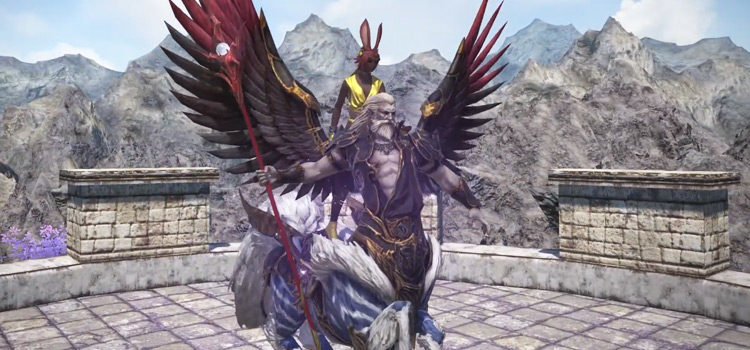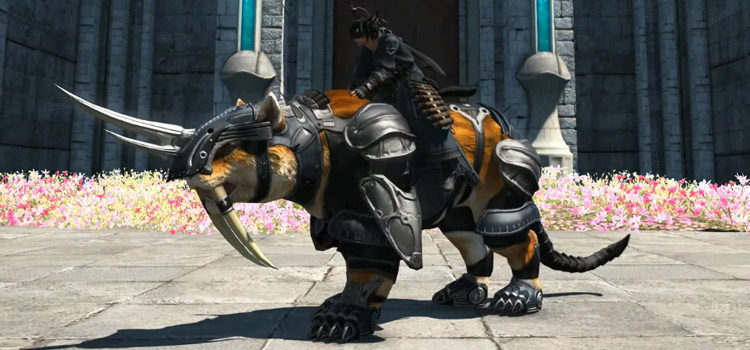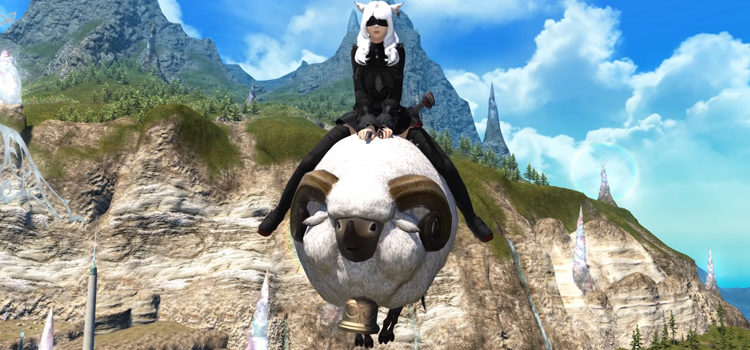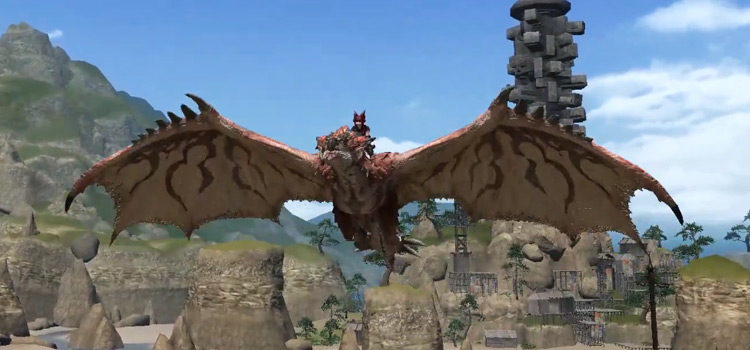5e Spell Guide: Phantom Steed, Mounts, and Motorcycles
This post may contain affiliate links. If you buy something we may get a small commission at no extra cost to you. (Learn more).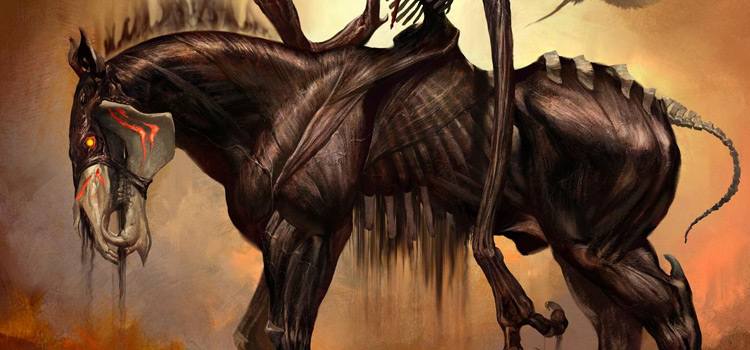
Let’s talk about one of the best mounts in the game, galloping, and how to make a totally by-the-rules motorcycle. Or a small car.
All can be done with phantom steed.
Phantom Steed
School: 3rd Level Illusion Spell
Casting Time: One Minute (Ritual)
Range: 30 feet
Components: V, S
Duration: One Hour
The spell creates a large, horse-like illusory creature. You get to decide how the creature looks, and it comes with a saddle, bit, and bridle already equipped. The tack is a physical illusion too, and vanishes when the spell ends or if taken too far away from your steed.
As long as the spell lasts, the phantom steed spell allows you or another creature to ride the solid illusion horse.
It uses the riding horse statistics, but its speed is increased to 100 feet per round. The spell details travel speed for the phantom horse, but we’ll get to that later.
The spell ends if you take an action to dismiss the horse, or if your steed takes any damage. When it ends, the steed doesn’t just vanish. Instead, it slowly fades away, giving you a minute to dismount.
Who Gets Phantom Steed?
This is exclusive to the wizard spell list.
Arcane Trickster rogues and Eldritch Knight fighters can learn it from that list.
They probably won’t, however, since neither subclass gets Ritual Casting as one of their abilities. If they wanted to cast the spell, they’d have to use one of their few spell slots.
Although the spell is only on one class list, almost anyone can get access to the spell. Phantom steed is a ritual, so it’s relatively easy to get ahold of this particular spell.
Pact of the Tome warlocks can add phantom steed to their Book of Shadows with the Book of Ancient Secrets invocation. The invocation gives ritual casting to the warlock, and they can learn ritual spells from any class list, including the wizard’s.
They won’t be able to learn the spell immediately. But they can copy into their Book of Shadows if they find a scroll of phantom steed, or if they can convince someone else to let them copy it into their book.
So long as you use feats in your game, anyone can learn phantom steed (eventually) by taking the Ritual Caster feat. Again, you won’t get the spell immediately, but you can add it to your book if you find it.
You’ll need an Intelligence or Wisdom score of 13 or higher to take the feat.
Technically, bards can select phantom steed as one of their Magical Secrets, allowing them to learn spells that aren’t on their class list. The spell competes with other favorites like counterspell or fireball, so most bards may have another spell in mind.
Phantom Steed Related Rules
Because the phantom steed is a mount, using it relies on the rules for mounts and travelling long distances.
If you’re familiar with the rules for mounts and travel pace in 5th edition, feel free to skip ahead to the Tips and Tricks section.
Travel Pace
Mounts and travel pace gets … complicated. Short version, most humanoids in D&D have a movement speed of 30 feet per turn.
Because this is the normal speed for most PCs (ignoring fast monks or dashing rogues), 5th edition says that the average party can travel about 3 miles in an hour on foot. That lets them cover about 24 miles in a day.
If you want to be stealthy, you have to go slow. You decrease your normal speed by one-third. That drops you from 3 mph to 2.
If you want to go fast, you take a penalty to your Perception, but you can increase your speed by one-third to 4 mph.
Check page 181 in the Player’s Handbook for the rules on travel pace.
Mounts
When dealing with horses, ponies, camels, and other normal mounts, their speed actually doesn’t matter for your travel pace.
The general idea is that you’ll need to walk them sometimes, stop for food or water, and they might be carrying some of your gear.
If you have a special mount or vehicle, things get more complicated. This includes things like magic carpets, airships, and phantom steeds.
Page 242 in the Dungeon Master’s Guide gives us the rules for a Special Travel Pace. The short version is that you take the creature or vehicle’s speed and divide it by 10 to find out how many miles it can go in an hour.
For the phantom steed, it has a movement speed of 100 feet, which comes out to 10 miles in an hour. That matches the speed listed in the spell text.
This checks out for our average adventurer too. With a movement speed of 30 feet, that brings us to 3 miles per hour at a normal pace on foot.
Galloping
If you’ve ever played D&D with someone who was really into horses, the way that mounts work in 5e may have … raised some eyebrows.
Like a lot of 5th edition, the rules for mounts and travel try to make things simple.
Unfortunately, that simplicity sometimes comes at the cost of accuracy.
In 5th edition, a character on a mount can ‘gallop’ for an hour. This lets them travel at twice the normal distance for a fast pace. The text mentions switching mounts repeatedly along the journey, allowing for people to cover large distances relatively quickly.
For 5e’s riding horses, this means they can gallop over the course of an hour to travel about 8 miles.
The thing is, that’s not a gallop. A gallop is a particular gait that horses have, along with the trot, the canter, and a couple other gaits. The gallop is what comes to mind for most people if they think of horse racing.
Horses also don’t gallop for anywhere close to an hour. Depending on the type of horse and the race, they’ll go about 30 mph for maybe 1 to 2 miles.
Horses in the Kentucky Derby only run about one and a quarter miles. Same for the Dubai World Cup.
Now, horse riding is a complex topic and I’m oversimplifying horses and how their gaits work.
5e, understandably, tries to simplify it down to something that people can easily use in their games.
The only real place this becomes a problem is if you want to actually gallop at a horse’s real top speed. Unless you need to cover that one mile as fast as you can, it’s not that big a deal.
Horse racing and high speed chases are a lot less exciting when you’re going a top speed of 8 miles an hour. But if everything is moving at that much slower speed, then it still mechanically works.
Mostly.
At the very least, it’s still fair for whoever is in the middle of their horse race or horseback chase through the woods.
You’re covering less distance, but it generally won’t matter.
Phantom Steed: Tips, Tricks & Uses
Let’s start with some appearance ideas.
Appearance
According to the phantom steed spell, “you decide the creature’s appearance”. This lets you use the spell to create any large-sized creature. Including ones that would make sense to your character’s homeland.
Did you grow up around dire wolves? Congratulations, you can make a dire wolf steed. Are you from a desert? You could make a camel. Maybe your steed looks like a giant lizard, or even a chocobo. Sorry, I mean ‘axe beak’.
A firenewt would presumably create a giant strider-looking steed. Drow could make a steed that looks like any of the several kinds of giant spider that live in the Underdark. Out of the Abyss mentions duergar (grey dwarves) using spider-like giant ‘steeders’ as mounts and beasts of burden.
You could make the steed look like a unicorn, a pegasus, a chimera, or even a dragon. The statistics don’t change, however. Whatever you’re riding, it has the statistics of a riding horse (apart from its speed).
That means no flying, climbing, swimming, or burrowing speeds that a ‘real’ version of your phantom steed might have.
Speed
The phantom steed spell comes with a lot of benefits. The fact that you don’t have to feed it is one – no more hauling around horse feed in saddlebags during your adventures.
The phantom steed’s much higher speed is another plus. The spell provides a shortened version of the travel pace rules: the steed can travel 10 miles in an hour, or 13 miles if you want to go at a fast pace.
13 miles an hour is nice in 5e, but we can do better.
The Dungeon Master’s Guide goes into more detail about the phantom steed, using it as an example of a magical ‘special travel pace’. It explicitly says a phantom steed doesn’t tire like a real horse, allowing it to travel 7 miles an hour at a slow pace, 10 mph at a normal pace, or 13 mph at a fast pace.
The phantom steed is also a mount, which means you can ‘ride at a gallop’, bringing the phantom steed’s travel pace speed up to 26 mph.
Add an item like the horseshoes of speed, and you increase the steed’s movement by 30 feet. That’ll bring the steed’s fast travel pace to 17 mph, allowing it to go 34 mph at a gallop.
Creating Multiple Steeds
Phantom steed isn’t a quick spell. It takes a minute to cast normally, or 11 minutes if you’re casting it as a ritual (which lets you avoid using a spell slot).
The horse lasts for an hour after you create it. However, there’s nothing technically stopping you from creating more phantom steeds while riding another one.
The Player’s Handbook details the rules for spells with longer casting times on page 202. You have to use your action each turn to cast the spell, and you have to maintain concentration while you do so. Nothing in the rules says you can’t cast a ritual while riding.
Ultimately, this means the party wizard could summon multiple steeds for the whole party, giving them a series of one-hour-lasting mounts. Mounts that you don’t have to feed or figure out a way to keep safe while you explore a dungeon.
The caster will need to cast the spell again and again, spawning one replacement steed after another.
Depending on your DM, they might allow you to simply re-create the steed beneath yourself or an ally, allowing you to keep riding without interruption. If they don’t, you’ll simply need to dismount one horse and mount the newer one.
Or you can come up with some kind of dangerous way to jump from one horse’s saddle into another. If you’re a rogue with Reliable Talent and a good acrobatics bonus, you’ll probably be fine.
Fading Away
The steed goes away if it takes any damage. But it doesn’t just poof out of existence beneath you. It gradually fades over the course of a minute.
Even if the steed takes enough damage to normally kill a riding horse outright, it still just slowly fades away.
There have been questions about whether or not you can ride the steed while it’s fading. According to Jeremy Crawford, you’re not supposed to be able to ride it while it fades away, but it won’t break the game if your DM lets you.
Motorcycles: Phantom Steed or Steel Horse?
Since Baldur’s Gate: Descent into Avernus, characters technically have the opportunity to pick up an actual, if hellish, motorcycle. Called a ‘devil’s ride’, this Mad Max-inspired war machine runs on captured souls trapped inside steel coins.
Understandably, some characters may be a bit squeamish about sacrificing the soul of a sentient creature to power their bike.
The good news is, you don’t have to.
We can use the phantom steed spell to basically ‘make’ a motorcycle, assuming it fits with the world you’re playing in.
Even if more modern tech is relatively limited in your game, who knows what kinds of ancient artifacts might be out there. Maybe you can convince your DM to allow your phantom steed look like Link’s Master Cycle from the Zelda series.
Step 1: Appearance
The spell literally says you pick the phantom steed’s appearance.
Like Air Bud, there’s no rule that says the phantom steed can’t be a motorcycle.
Granted, the phantom steed does have some level of intelligence, so we’re getting a little bit closer to KITT from Knight Rider.
Well, a little closer. An Intelligence score of 2 is definitely too low to mimic a talking car.
Maybe it’s more like Herbie – and I’d personally consider a 1963 VW Bug to be size ‘large’.
Step 2: Speed Boosts
The first real-world motorcycles weren’t incredibly fast. By those standards and compared to everything else in 5e, 26 mph isn’t anything to sneeze at.
The devil’s ride, for comparison, is stuck going at a top speed of 16 mph for any extended length of time. Sort of.
I can’t find any ruling about whether the devil’s ride can technically gallop.
The gallop mechanic more or less represents a creature using their action to dash every turn, which a devil’s ride can do. If it can gallop, that brings it up to 32 mph.
Anyway, just because the phantom steed is faster than most mounts shouldn’t stop us from trying to make it go faster.
Apart from the horseshoes of speed, there’s a number of different ways to get a little more movement out of your phantom steed.
A Transmutation wizard can give their Transmuter’s Stone to their steed, potentially adding another 10 feet of movement. This only helps that one steed, but if you’re riding solo, that won’t be a concern.
Artificers, Bards, Druids, Rangers, and Wizards all have access to the longstrider spell, which can add another 10 feet to the steed’s normal movement. Longstrider will only last an hour, but that’s also as long as each individual phantom steed can be used.
Starting at level 18, an example Transmutation wizard could pick longstrider as the 1st level spell they can cast endlessly for free with their Spell Mastery feature. That’ll up the phantom steed’s movement to 150 feet per turn with the horseshoes and Transmuter’s Stone, or 40 miles per hour at a gallop.
That’s not bad, but … let’s double it.
Step 3: Party Shenanigans
Paladins who take the Oath of Glory can give 10 extra feet of movement to any ally close to them—which includes their mount and the mounts of anyone riding alongside them.
If you really want your party to dominate the open road, you’ll need a Path of the Totem Warrior barbarian.
At level 6, this barbarian can pick an Elk totem feature that doubles their travel pace, whether they’re mounted or on foot. This benefit also extends to up to 10 travelling companions.
Pair that with an Oath of Glory paladin and a wizard ritual casting one phantom steed after another. Even without any items or individual bonuses, your party now has a normal travel pace of 22 mph (100 feet + 10 feet doubled).
That turns into a fast pace of 29 mph, or 58 mph at a gallop. (If you double the travel pace after calculating the fast pace, it’ll be 56 mph, but it’s a pretty insignificant difference at this point).
If you all happen to have horseshoes of speed, it’ll bring you up to 72 or 74 mph. With longstrider, and a mage who doesn’t mind casting it on each phantom steed as it’s made, we’re now going at a top ‘galloping’ speed of 80 mph.
Granted, this is something that won’t always come in handy.
But if you have the chance to magically create a herd of 80 mph horses or a fleet of motorcycles… why wouldn’t you?

